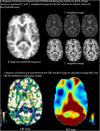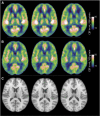Cerebral arterial bolus arrival time is prolonged in multiple sclerosis and associated with disability
- PMID: 24045400
- PMCID: PMC3887342
- DOI: 10.1038/jcbfm.2013.161
Cerebral arterial bolus arrival time is prolonged in multiple sclerosis and associated with disability
Abstract
Alterations in the overall cerebral hemodynamics have been reported in multiple sclerosis (MS); however, their cause and significance is unknown. While potential venous causes have been examined, arterial causes have not. In this study, a multiple delay time arterial spin labeling magnetic resonance imaging sequence at 3T was used to quantify the arterial hemodynamic parameter bolus arrival time (BAT) and cerebral blood flow (CBF) in normal-appearing white matter (NAWM) and deep gray matter in 33 controls and 35 patients with relapsing-remitting MS. Bolus arrival time was prolonged in MS in NAWM (1.0±0.2 versus 0.9±0.2 seconds, P=0.031) and deep gray matter (0.90±0.18 versus 0.80±0.14 seconds, P=0.001) and CBF was increased in NAWM (14±4 versus 10±2 mL/100 g/min, P=0.001). Prolonged BAT in NAWM (P=0.042) and deep gray matter (P=0.01) were associated with higher expanded disability status score. This study demonstrates alteration in cerebral arterial hemodynamics in MS. One possible cause may be widespread inflammation. Bolus arrival time was longer in patients with greater disability independent of atrophy and T2 lesion load, suggesting alterations in cerebral arterial hemodynamics may be a marker of clinically relevant pathology.
Figures






References
-
- Kutzelnigg A, Lucchinetti CF, Stadelmann C, Bruck W, Rauschka H, Bergmann M, et al. Cortical demyelination and diffuse white matter injury in multiple sclerosis. Brain. 2005;128:2705–2712. - PubMed
-
- Zeis T, Graumann U, Reynolds R, Schaeren-Wiemers N. Normal-appearing white matter in multiple sclerosis is in a subtle balance between inflammation and neuroprotection. Brain. 2008;131:288–303. - PubMed
-
- Soon D, Tozer DJ, Altmann DR, Tofts PS, Miller DH. Quantification of subtle blood-brain barrier disruption in non-enhancing lesions in multiple sclerosis: a study of disease and lesion subtypes. Mult Scler. 2007;13:884–894. - PubMed
Publication types
MeSH terms
Substances
LinkOut - more resources
Full Text Sources
Other Literature Sources
Medical

